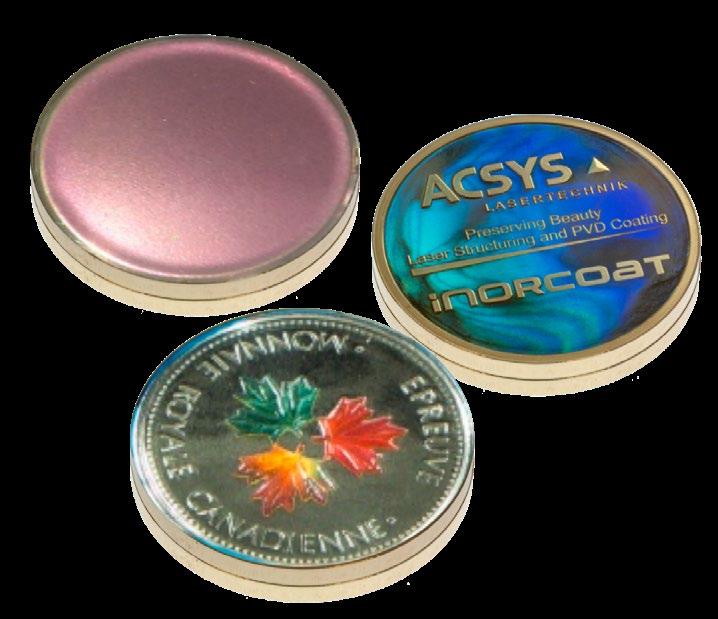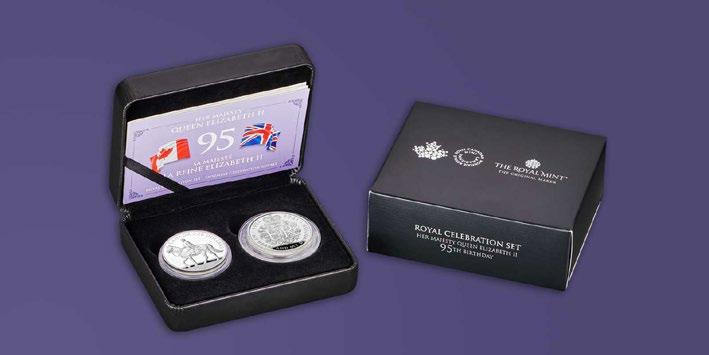
4 minute read
Coins and Medals – Nanotechnology Meets Pad Printing
The quality from the stainless steel satellites was very good and proof level but under closer scrutiny small dents were visible, caused by the textured surface edges of the steel satellites. These were not visible using the ceramic CHD balls, which produced a very smooth surface. For the softer fine silver striking tests, less aggressive stainless steel balls were used and achieved proof quality results with a smooth surface similar to that achieved using ceramic CHD balls. But by using a slightly more aggressive mixture, ceramic CHD pins and balls, an exceptionally smooth surface was achieved (see Fig 4). The media were also tested to establish their performance (chemical resistance) to pickling compounds. Three media types – a lower quality stainless steel (316), a higher quality stainless steel (316L) and ceramic balls CHD 33 were immersed in strong pickling acid for one week. The lower quality stainless steel showed considerable deterioration of its surface. The better quality stainless steel, which is more the industry norm, showed some but less deterioration than the lower quality stainless steel. There was no evidence of chemical attack on the CHD ceramic balls. In summary, the trials indicated that, having strong chemical resistance, the now commercially available ceramic CHD media, either alone or in mixtures with stainless steel media to tailor the surface structure, could produce blanks with homogeneous surface structures that produced excellent striking results on silver blanks as shown in the study. But the application range is not limited to precious metals. The new media generation is also designed for the finishing of circulation coin blanks, especially the new CHD satellite shape.
Colours on coins is not new. The three well known techniques are pad printing, laser engraving and PVD (physical vapour deposition) coatings. Two companies, Inorcoat and Teca-Print, have explored the possibility of combining the benefits of these known technologies to create unique coins, as Roman Waidelich (CEO of the former) and Daniel Fahl (CEO of the latter) explained in their presentation.
Inorcoat, which was founded in 2019 with sites in Germany and Bulgaria, produces plasma components and PVD equipment, along with solutions for die coating and decorative coating on coins. Teca-Print AG, founded in 1973, is based in Switzerland with subsidiaries in Germany, Hungary and France, and produces pad printing machines and consumables. Laser engraving is a structure applied by a laser onto a die which is then used to strike blanks to produce coins. Laser engraved dies produce coins that show rainbow colours due to interference, ie. the relief matrix created by the laser reflects light in different directions. When making such dies, it is important the design allows for a sufficient number of strikes before the die is replaced due to wear, enabling an economic quantity of coins to be produced. One method used to increase die life is PVD coating. Pad printing is a flexible process enabling ink to be printed by direct contact in a specific place on the minted coin. It offers a wide choice of designs, for example using CMYK printing (Cyan, Magenta, Yellow and Black) or using specific colours created by mixing pantone or RAL colours. It can also be used for special inks such as those with sparkle effects, those which glow in the dark, interference inks (the colour shade is changes depending on the angle of view), etc. The process enables sharp images anywhere on the coin. It can be a single print unit or as a high speed automated unit with multiple stations. A limitation of pad printing, however, is printing into sharp engraved edges. PVD is a physical, environmentally friendly process and, although a range of colours or interference colours can be created, each will be all over on surface of the coin unless a mask is used, but this is complex and costly. However, an advantage of this process is that the PVD reaches virtually all areas, so it penetrates the deep engraved areas which the pad printer cannot. The challenge was to combine pad printing and PVD coating techniques to create a new and unique type of coin. This could be cost effective, especially if the two processes already exist in the mint. The method chosen was to pad print on to pre-PVD coated coins. This worked extremely well, not least because the PVD coating presented a highly receptive surface for the pad printing, resulting in high ink adhesion. Having proven that the two processes could be combined to create unique coins, the two companies tackled the question of ‘where next?’. The potential for uniqueness using the process described is limited only by PVD coating colours and graphic designs; in effect, almost limitless possibilities exist. So, more work to design and create unique and attractive coins using the two processes continues and a mint is being sought to cooperate on this programme. A further project is to develop selective PVD coatings

Eliminating harmful plating
A related but different opportunity has been identified. One of the last galvanic treatments in the industry is the selective plating of gold and silver on coins and other materials. As such it is one of the last harmful processes in the industry. This process could, potentially, be eliminated by PVD coating. This could be achieved by creating a mask using the pad printing process prior to PVD coating the gold or silver. The mask would have to survive the environment in the PVD coating process and be easily removed after the coins have been coated. Research has begun on this project.




